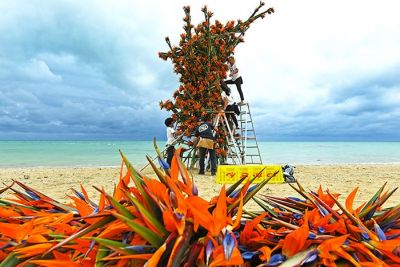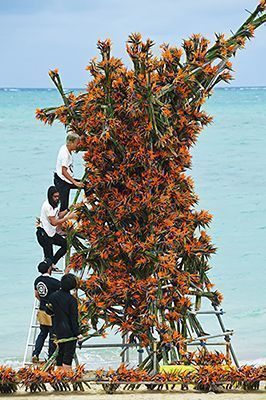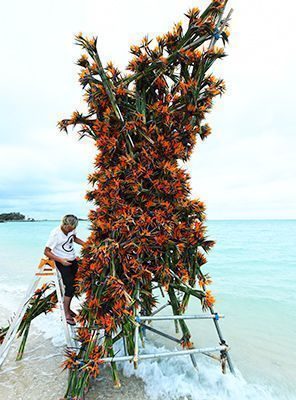Flower art blooms on the beach: giant plant sculpture created using 8,300 Strelitzia

Project members working on the plant sculpture using fresh flowers from Okinawa in the afternoon of October 11 at Hyakuna Beach in Tamagusuku, Nanjyo City (taken by John Matsumoto)
October 12, 2018 Ryukyu Shimpo
On October 11, a giant plant sculpture over 6 meters tall luxuriously using about 8,300 Strelitzia flowers, known for its distinctive orange and blue, appeared on Hyakuna Beach in Tamagusuku, Nanjyo City on the southern part of the main island of Okinawa.
A successful flower artist in and outside of the country, Makoto Azuma created the sculpture. The plan was to complete the sculpture by around noon on October 12.
Followed by cutting the flowers into pieces and distributing them to Hyakuna Beach visitors around 3 p.m. the same day.
Offering A Way of Enjoying the Flower
Azuma has managed flower shops since 2002 and currently manages a flower shop in Minamiaoyama, Toyko. Beginning around 2005, in addition to running a flower shop, he began taking part in artistic expression using plants.
Okinawa Prefecture is the number one producer of Strelitzia flowers in Japan.
However, the Strelitzia flower is not well known even by Okinawan citizens.
When rephrased as “Gokurakuchoka (Elysium bird flower),” the reality is that people unfortunately think of them as flowers for a household Buddhist altar before anything else.
Though this grand creation, Azuma hopes to offer a new way of enjoying the flower.

Makoto Azuma working on the plant sculpture using fresh flowers from Okinawa in the afternoon of October 11 at Hyakuna Beach in Tamagusuku, Nanjyo City (taken by John Matsumoto)
Regarding his motivation for this creation, he said, “(Strelitzia flowers) are dynamic and fascinating flowers.
Through this work of art, I hope people are able to enjoy them with a new perspective.”
On the first day on October 11, Azuma continuously worked on the sculpture between 9:30 a.m. to past 6 p.m. without taking decent meals.
He used up about 8,300 Strelitzia flowers and assembled the general framework of the sculpture.
The plan was to finalize it starting the morning of October 12.
After adding an additional 700 or so red lobster-claw flowers, it was to be completed around noon.
Since the sculpture would be taken part by the afternoon, people could only look at the completed sculpture for a limited amount of time.
Azuma reiterated the significance of the creation as he said, “As long as it remains in peoples’ memory after receiving the cut flowers that are handed out.”
Adding One Flower at a Time During High Tide
About 8,300 Strelitzia flowers were arranged on the beach, then Azuma and the production members worked together to complete the creation by adding one flower at a time.
Strelitzia flowers were inserted from various angles to a metal-piped frame.
The staff occasionally looked at the creation from a distance to check the shape as to “not ruin the outline and to listen to the voice of the flowers.
” The staff were seemingly trying to “become one with the flowers.”
In the evening, the tide creeped into the work area, causing waves to surround the scaffolding.

Project members working on the plant sculpture using fresh flowers from Okinawa in the afternoon of October 11 at Hyakuna Beach in Tamagusuku, Nanjyo City (taken by John Matsumoto)
Being exposed to strong beach winds and getting their feet wet helped actualize the image of the sculpture in the staff’s minds.
Ardent Eyes and the Wishes of Those Who Grow Strelitzia
Around 2 p.m. on October 11, about 25 members who grow Strelitzia came to observe the creation.
These members are from the JA Okinawa Tsukazan Branch Flower Plants Growing Subcommittee.
An order of 8,300 Strelitzia all at once was an order so large that even the JA executive said, “It’s unheard of.” The subcommittee Chairman Yukio Kamizato watched the Strelitzia flowers shipped from his own farm turn into a magnificent creation.
He smiled as he said, “I’m happy an artist turned Strelitzia flowers into art like this.”
Between the end of September and beginning October, there were two typhoons that hit Okinawa, damaging the flower plants within Okinawa. Subcommittee members worked together to gather those Strelitzia that “survived” those typhoons.
One of the Greatest Producers, Yet Not Known Well Enough?
With Okinawa’s warm climate, growing flower plants flourishes primarily around periods where production decreases at growing centers outside of Okinawa. This period is called “between-crops season.”
Shipment periods are adjusted via greenhouses and artificial light cultivation to systematically grow them.
For the New Years and equinoctial week, groups arrange for additional flights to help with shipments.
So much so that Okinawa produces 90% of all small chrysanthemums in the country during equinoctial week.

Makoto Azuma (top right) working on the plant sculpture using fresh flowers from Okinawa in the afternoon of October 11 at Hyakuna Beach in Tamagusuku, Nanjyo City (taken by John Matsumoto)
However, this is not known by many Okinawan citizens.
A representative of JA said, “Even during Governor Onaga’s funeral open to the citizens, there were many flowers from Okinawa on the altar.
But there weren’t many who paid attention to them.”
Okinawa may be the number one producer of Strelitzia in Japan.
But as the representative spoke on behalf of the those who grow the flower said, “Even if a person says their job is ‘growing Strelitzia,’ people have a hard time understanding that because it is not very well known.
At the same time, it conjures an image of flowers for household Buddhist altars, so you don’t get a good response even when you tell them wha

Makoto Azuma working on the plant sculpture using fresh flowers from Okinawa in the afternoon of October 11 at Hyakuna Beach in Tamagusuku, Nanjyo City (taken by John Matsumoto)
t it is.”
Strelitzia, also called “Gokurakuchoka (Elysium bird flower),” is called “bird of paradise flower” in English. Those who grow them emphasize the
brightness of the flower.
One person said, “I’d like people to use them in a wide variety of scenes and not just during ceremonial occasi
ons.
They’re pretty even when you put them in a vase by themselves.
Sometimes we even give (out of spec flowers) to relatives.”
The representative of JA said, “The flower is still not known by many and there aren’t enough successors.
There is a sense of danger that the flower itself may disappear (from a lack of interest).”
The representative also added, “I want locals to see this Strelitzia creation and to learn about a flower that is familiar to Okinawa.”
As a Person Who Expresses Himself Through Flowers

Makoto Azuma (top left) and project members working on the plant sculpture using fresh flowers from Okinawa in the afternoon of October 11 at Hyakuna Beach in Tamagusuku, Nanjyo City (taken by John Matsumoto)
On October 11, Azuama who worked on the sculpture for several hours said with a fulfilled smile, “There aren’t many opportunities to arrange eight-thousand Strelitzia flowers, so it’s a luxurious experience. As a person who expresses himself through flowers, I wanted to experience something I had never experienced before.”
Up until now, Azuma has created a flower sculpture using flowers purchased at a Thai market and created a piece made from sunflowers at a salt lake 3,500 meters above sea level.
Azuma spoke of the allure and said, “As you arrange local flowers around the world, it’s interesting because it changes the way we capture flowers.” Azuma plans to record the Strelitzia sculpture via footage and photos and plans to exhibit them during the modern art event that is to be held in Argentina in 2019.
(English translation by T&CT and Chelsea Ashimine)
Previous Article:“I Lost My Voice:” Naha’s Giant Tug-of-War Unites Tourists and Locals
Next Article:Former governor Onaga’s prefectural funeral teems with 3,000 people saying final farewells
[Similar Articles]
- Okinawan flower lovers taking care of endangered “mustard-like” flower
- Damaged roof tiles from Shuri Castle used to make flower bed, providing new home to 300 flowers at Tsuboya Elementary School in Naha
- The brilliant blooming of rhododendron flowers in the rain heralds in spring in Ginoza Village
- Community members pray for good harvest at Ueda Ugan
- Narcissus in full bloom on Iejima
 Webcam(Kokusai Street)
Webcam(Kokusai Street)


